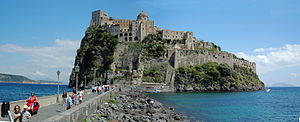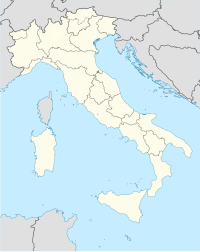| Aragonese Castle Castello Aragonese | |
|---|---|
| Italy | |
 Aragonese Castle | |
| Site history | |
| Materials | Limestone |
Aragonese Castle (Italian language: Castello Aragonese ) is a medieval castle located in Ischia, at the northern end of the Gulf of Naples, Italy.[1]
The castle which stands on a volcanic rock, is the most impressive historical monument in Ischia, built by Hiero I of Syracuse in 474 BC. At the same time, two towers were built to control enemy fleets' movements. The rock was then occupied by Parthenopeans (the ancient inhabitants of Naples). In 326 BC the fortress was captured by Romans, and then again by the Parthenopeans. In 1441 Alfonso V of Aragon connected the rock to the island with a stone bridge instead of the prior wood bridge, and fortified the walls in order to defend the inhabitants against the raids of pirates. Around 1700, about 2000 families lived on the islet, including a Clarisses Convent, the Abbey of Basilians from Greece, the Bishop and the Seminar, the Prince with a military garrison. There were also thirteen churches. In 1912, the Castle was sold to a private owner. Today the castle is the most visited monument of the island.
It is accessed through a tunnel with large openings which let the light enter. Along the tunnel there is a small chapel consecrated to Saint John Joseph of the Cross (San Giovan Giuseppe della Croce), the patron saint of the island. A more comfortable access is also possible with a modern lift. After arriving outside, it is possible to visit the Church of the Immacolata and the Cathedral of Assunta. The first was built in 1737 on the location of a smaller chapel dedicated to Saint Francis, and closed after the suppression of Convents in 1806 as well as the Nunnery of Clarisses.[1]
See also[]
References[]
- ↑ 1.0 1.1 "Castello Aragonese (Aragonese Castle)". gardenvisit.com. http://www.gardenvisit.com/garden/castello_aragonese/. Retrieved 6 December 2010.
External links[]
| Wikimedia Commons has media related to Castello Aragonese of Ischia. |
The original article can be found at Aragonese Castle and the edit history here.
